How do bicycle works
Classical Mechanics
Level
3

During paddling of a bicycle ,the force of friction exerted by the ground on the two wheels is such that it acts
in the backward direction on both the front and the rear wheels
in the backward direction on the front wheel and in the forward direction on the rear wheel
in the forward direction on both the front and the rear wheels
in the forward direction on the front wheel and in the backward direction on the rear wheel
This section requires Javascript.
You are seeing this because something didn't load right. We suggest you, (a) try
refreshing the page, (b) enabling javascript if it is disabled on your browser and,
finally, (c)
loading the
non-javascript version of this page
. We're sorry about the hassle.
In bicycle, pedalling is done on rear wheel. This means that we try to rotate the rear wheel to move forward. The rear wheel pushes the ground backwards and gets the forward frictional force which pushes the bicycle forward. The front wheel is being pushed forward (through the connecting rod between the rear and front wheels) which results in the backward frictional force on its tire which rotate it in the same direction as the rear wheel. The static frictional force which acts on both the wheels is a friendly force that helps the bicycle move without loss of energy. Energy loss is due to rolling friction which is backwards on both the wheels. Conclusion: Backward static frictional force (opposite to the direction of motion) on the front wheel and forward static frictional force (in the direction of motion) on the rear wheel. Rolling frictional force is backwards on both the wheels. There will be no kinetic friction on the bicycle unless it skids due to sudden application of brakes or due to muddy and slippery road.
As the bicycle tires are moving in the anticlockwise direction, bicycle is moving from right to left. In this case, ( i ) Static frictional force acts on the front wheel from left to right (opposite to the motion of the bicycle) and on the rear wheel from right to left (in the direction of motion of the bicycle). This is a friendly force which helps bicycle move forward and no work is done against it. (ii) Rolling friction acts on both the wheels from left to right (opposite to the motion of the bicycle) and work is done to overcome it. (iii) Kinetic friction is absent as long as the bicycle does not skid. It is from left to right (opposite to the motion of the bicycle) in the case of skidding. If kinetic frictions acts, work will have to be done against it which will result in loss of kinetic energy and hence speed of the bicycle. (iv) There is also the frictional force in the bearings of the wheels which will need more force to accelerate the bicycle and more energy to maintain the speed if the bearings are not sufficiently lubricated.